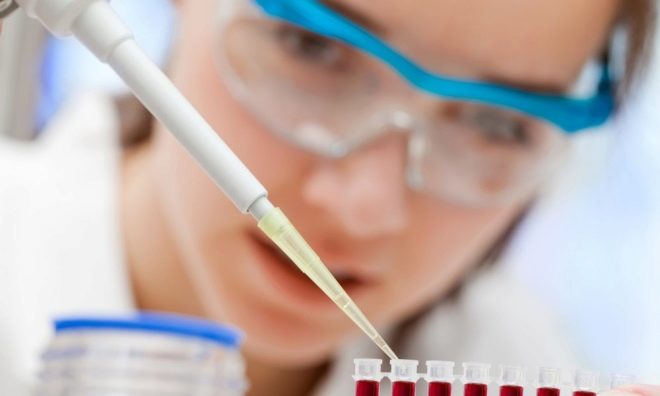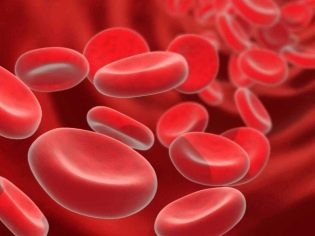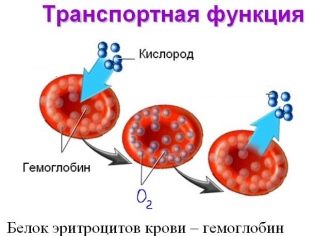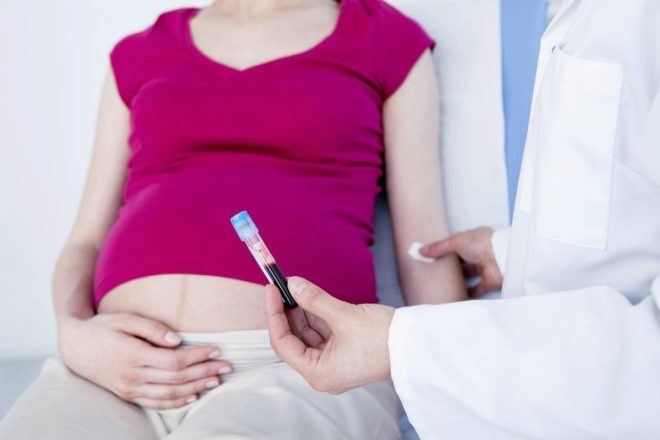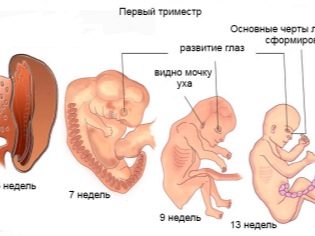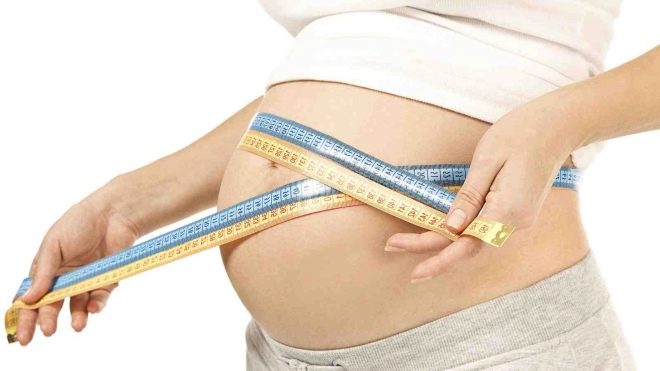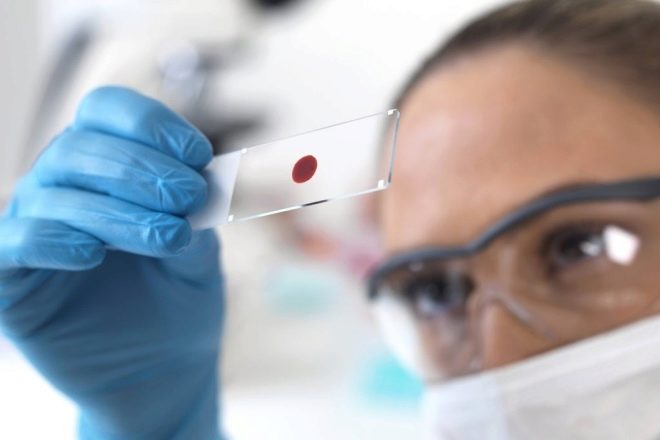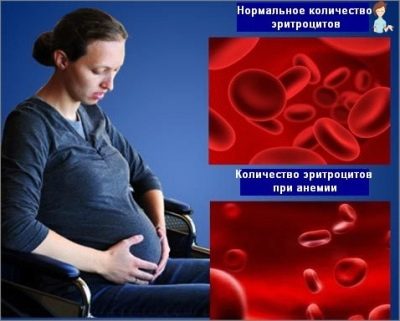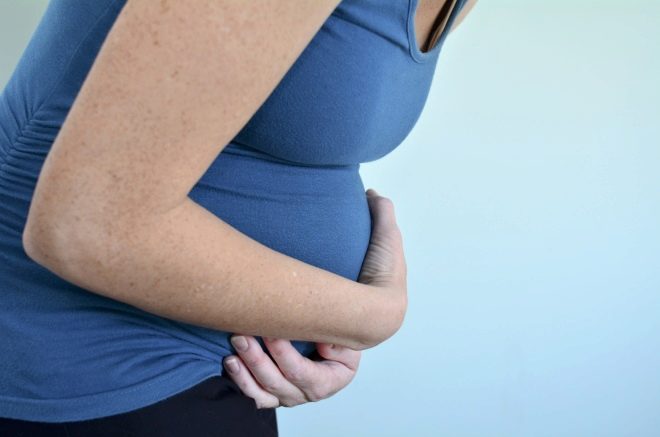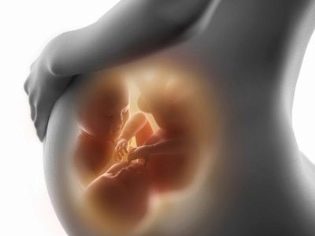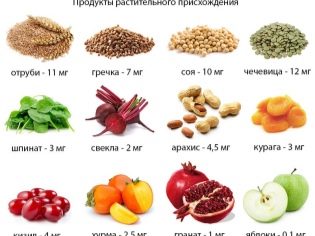What values of hemoglobin in pregnant women are considered the norm and what to do in case of deviations?
Blood tests during pregnancy are repeated. They are necessary to identify pathologies at the earliest stages of both the expectant mother and her baby. One of the important indicators in the blood is hemoglobin level.
What it is?
Complete blood count is a very important study that is carried out during childbirth. Its performance in the first trimester may differ significantly from those in the third trimester of pregnancy. These differences are due to the physiological characteristics of fetal development. As the baby grows, it needs a lot more oxygen.
Hemoglobin is a special blood protein. It is located inside the special blood cells - red blood cells. The hemoglobin contains iron and the organic part. This structure allows these protein particles to carry oxygen to all the cells of the internal organs of both mother and her baby.
For the implementation of all vital processes in the children's body requires nutrients. Oxygen is a natural catalyst for almost all reactions that occur every second in the cells of all internal organs. Active growth and development of the body systems of the fetus leads to the fact that the need for these substances increases many times.
The absence or insufficient supply of oxygen and nutrients to the cells of the developing baby can lead to the development of a very dangerous state - hypoxia. This pathology does not allow the child to fully grow and develop in the womb. If this condition is not corrected in time, it can lead to the formation of various intrauterine pathologies in the fetus.
Doctors note that there may be several hemoglobin jumps during the entire pregnancy. The degree of their severity depends largely on the initial well-being of the future mom. If a woman had any blood disorders or anemia before the pregnancy, then such manifestations may be most pronounced. In this case, the intervention of specialists may be required.
Iron is an important element that is contained in hemoglobin. This substance is necessary for the implementation of many redox reactions in the body. To maintain good functioning requires that the concentration of iron in the blood was in the normal range. An increase or decrease in the level of this substance in the blood leads to the development of various pathologies.
Norms of iron depend on age. Thus, its normal values in children and pregnant women are slightly higher than in middle-aged men. The need for iron increases significantly during periods of active growth and development. Also, the utilization of this substance at this time increases significantly.
Iron is not synthesized in the human body. To maintain its constant normal concentration requires its regular flow from outside. For this, future moms doctors write out a special diet that includes foods rich in this substance. Any errors in such medical nutrition will only increase the negative manifestations.
The level of hemoglobin in different periods of fetal development is different. In order to timely identify emerging pathologies, doctors created special laboratory criteria. They allow you to separate the norm from pathology.
It is important to note that hemoglobin is determined only in the blood. In urine and other biological fluids, this indicator is not investigated.
Such laboratory criteria are compiled for each period and week of pregnancy. These tables are used by physicians of different specialties who observe pregnant women. Hemoglobin shows them the severity of various functional disorders that form during different periods of pregnancy.
Norms in pregnant women
Obstetricians and gynecologists point out that during the entire period of pregnancy it is very important to evaluate the hemoglobin values in the blood. Any deviations from the norm should be an important reason for a more advanced diagnostic complex. Pronounced deficiency or increase in the concentration of hemoglobin in the blood - this is the indication for referral to a consultation with a hematologist.
Normal values of these protein molecules in the blood are largely dependent on the obstetric gestational age. It is measured in weeks. Given the obstetric period, the entire period of pregnancy is divided into 3 trimesters. In each of them for 12 weeks. This division is used by doctors of all specialties when working with pregnant women.
First trimester
This period includes the first twelve weeks. This period is very important for the future baby. It is in the first trimester that the baby forms all the vital organs and systems. Doctors call this process organogenesis.
The significance of this period can not be overestimated. In the future, he, as a rule, determines how well all the systems of internal organs have developed in a baby. Many genetic diseases or chromosomal defects can occur at this particular time.
A change in the hemoglobin concentration in the mother’s blood during this period can lead to the formation of various intrauterine developmental defects in the child. That is why in the first trimester of pregnancy, the future mom can undergo a complete blood count quite often.
For optimal growth and development of the embryo during this period, a full range of nutrients, oxygen and trace elements is required. About this expectant mother should certainly remember. Compliance with the recommendations of the doctor and proper nutrition - a pledge of the normal course of the first trimester of pregnancy.
At this time, normal hemoglobin values in the blood are indicators from 112 to 159 g / liter. Any deviations from the norm must necessarily be the reason for carrying out an extended diagnostic complex. In this case, the expectant mother may need to pass additional biochemical tests and undergo an ultrasound. All these studies will be assigned to a pregnant woman by her obstetrician and a general practitioner.
In the second
This time of pregnancy is also very important. It lasts up to 28 obstetric weeks. At this time, the baby continues to actively grow and develop in the mother’s tummy. His heart has been beating for a long time. By the middle of the second trimester, the future mom can feel her baby starting to push.
The circumference of the "pregnant" tummy continues to grow. This is a very important and good sign, indicating that the baby is growing and developing. To monitor fetal intrauterine development at this stage, doctors also prescribe future moms to undergo general blood tests, assessing hemoglobin values.
Actively developing baby requires more oxygen. This leads to normal hemoglobin values in this period of pregnancy begin to decrease. This is a functional norm. Normal values consider the concentration of 108-144 g / liter.
Experienced technicians determine the level of hemoglobin in the blood "by eye". This is possible when donating blood for a general analysis. If the hemoglobin concentration becomes too low, then the blood looks very fluid. An increase in the blood plasma of this substance leads to its substantial concentration, and in some cases even contributes to thrombosis.
In third
This gestation period starts from the 29th obstetric week. This is the final stage of carrying a baby and a kind of preparation for childbirth. During the normal course of pregnancy, it is only necessary to control the level of hemoglobin in the blood. If the doctors revealed some pathology in the earlier trimesters, then it may be necessary to take tests more often.
At the final stage of carrying a baby, the hemoglobin concentration in the female body is 110-139 g / liter. Subsequently, these norms will be approximately the same after childbirth. In a newborn baby, hemoglobin values in the blood will change monthly in the first year of life.
With the pathological course of pregnancy during this period of pregnancy, as a rule, the indicators of this protein component are often low. High hemoglobin in the third trimester is still much less common. If the future mommy has diabetes, then often, in addition to an altered iron concentration, she will have increased glycated hemoglobin.
Below is a summary table of normal hemoglobin values in the blood by week of pregnancy:
Duration of gestation (week) | 12 | 16 | 20 | 24 | 28 | 32 | 36 | 40 |
Hemoglobin, average values (g / liter) | 109 110 111 113 | 105 106 107 108 | 104 105 106 | 105 106 | 106 107 | 110 | 114 115 116 | 117 118 119 |
Reasons for raising
Not always increase in the blood of hemoglobin happens in pathologies. Interestingly, the future moms who live in high mountains, there is a physiologically high concentration of hemoglobin in the blood. This feature is due to the presence of a huge amount of oxygen dissolved in the air.
Future mummies who live in ecologically clean places can also have a slightly increased level of hemoglobin in the blood. If there are no other changes in the blood, then you should not worry about it. After the birth of the baby, these indicators are normalized.
A significant increase in hemoglobin in the blood of a pregnant woman is, as a rule, a manifestation of pathology. The development of such a situation in most cases lead deficient states for vitamins B9 and B12. These substances are necessary for many hematopoietic reactions that develop in the body of the future mom and her baby.
Increased hemoglobin may be a manifestation of chronic diseases of the gastrointestinal tract in a pregnant woman. It often happens that before the pregnancy, the expectant mother does not even know that she has such pathologies. Many of the diseases do not appear bright enough and have “erased” symptoms.
Diseases of the urinary tract and kidney can cause an increase in the blood of hemoglobin in the future mom. In this case, an additional complex of diagnostics is required. General analysis of urine, and in some situations, and bacposev will help doctors to establish the correct diagnosis. To clarify the pathology may also need an ultrasound.
In some situations, an increase in hemoglobin is a family feature. In this case it is imperative to clarify whether such occurrences have occurred in close family members Some genetic diseases are also accompanied by elevated blood levels of hemoglobin. However, it should be noted that an increased level of hemoglobin in this case is recorded in a woman before pregnancy.
An increase in hemoglobin during pregnancy is a very unfavorable symptom, which requires the mandatory consultation of a physician. Usually, treatment is prescribed if the concentration in the blood of this substance is higher than 160 g / liter.
High hemoglobin levels are very dangerous.especially over a long period of time. They can lead to an increase in blood clots.
Why is going down?
Doctors identify several causes that contribute to the development of an anemic condition. Anemia is a pathology in which the hemoglobin concentration is significantly reduced in the blood. These pathological conditions can be very different. Pregnant women are most common. iron deficiency anemia.
Below is a table of anemic states of severity:
Severity of anemia | Easy | Average | Heavy |
Hemoglobin, average values (g / liter) | 90, 92, 94, 95, 96, 97, 98, 100, 101, 102, 103,106,109. | 76, 80, 86, 87, 89 | 50, 56, 60, 68 |
Doctors note that most cases of anemia develop after 26-27 weeks of gestation. The presence of anemia is indicated when the figures obtained are below the lower limit of the established norm.
To establish a specific clinical variant of the anemic condition of the future mother, doctors can prescribe auxiliary tests. Usually they include the determination of serum iron, ferritin and other laboratory parameters.
Doctors use several classifications to assess the degree of anemia. When the concentration of hemoglobin in the blood from 90 to 110 g / liter anemic condition is mild. The average degree of disturbance is characterized by a decrease in this indicator below 89, but it still exceeds 70 g / liter. A lower concentration indicates the development of a severe anemic condition.
A variety of causes can lead to the development of such pathologies. The most frequent of them is the reduction of alimentary incoming iron. In this case, the macro does not get in enough with food. Quite often, this condition manifests itself in future moms who are on a vegetarian diet.
In the first half of pregnancy, toxicosis leads to the development of an anemic state. The most dangerous clinical options, accompanied by severe repeated vomiting. This condition leads to a decrease in the volume of circulating fluid, which contributes to the development of an anemic condition.
Taking certain types of drugs is also a starting cause leading to a decrease in the level of hemoglobin in the blood. Especially often such situations occur with prolonged use of drugs during pregnancy.
Immunosuppressive and anticancer drugs can lead to a decrease in hemoglobin levels. They are applied for strict medical reasons.
Diseases of the stomach and intestines can also lead to an anemic condition in the expectant mother. Ulcerative defects and erosive colitis, occurring with the development of clinical symptoms, can lead to a marked decrease in blood iron. These conditions are extremely unfavorable, especially during pregnancy. Treat them should still still before pregnancy.
Optimal bowel function is very important. It provides absorption of all nutrients, and also helps to maintain the constancy of microflora and vitamins in the body. Dysbacteriosis or irritable bowel syndrome is a common pathology in which anemic conditions are manifested. As a rule, the severity of functional disorders in this case is mild.
Persistent exhausting stress can also lead to a decrease in hemoglobin in the blood. The most dangerous prolonged stress effects. This contributes to a strong spasm of the blood vessels, which has only an aggravating effect on the development of the anemic state.
Multiple pregnancy - A common situation in which an anemic condition develops.Growing up in the mother's womb, babies consume large amounts of nutrients. This inevitably leads to the development of anemia in a pregnant woman. To compensate for this condition, doctors strongly recommend that expectant mothers who are carrying twins or triplets regularly take multivitamin preparations.
Another very interesting reason leading to the development of the anemic condition of the expectant mother is previous recent births. Obstetricians and gynecologists note that if a woman has a second pregnancy a year after the birth of her first baby, then the risk of developing her anemic condition increases several times. Typically, this pathology is fully normalized immediately after childbirth.
Symptoms
With a marked decrease in the hemoglobin concentration in the blood, the future mommy has specific symptoms. At first their degree of manifestation is insignificant. As hemoglobin concentration in the blood decreases, negative symptoms begin to progress.
First, the future mom feels only a small general weakness. She often tends to sleep. Pathological drowsiness at the same time bothers more in the first half of the day. With the progression of anemia, a pregnant woman has a feeling of lack of air. In some cases, sleep is disturbed. This symptom is usually severe. insomnia.
Tolerance to exercise is also significantly reduced. Mothers suffering from anemia in the third trimester of pregnancy, it is much more difficult to perform even the usual household loads. Climbing the stairs for several spans can also cause shortness of breath. This symptom progresses markedly with each subsequent week of pregnancy.
Women suffering from anemia, quite often complain of a headache. Usually it is of moderate intensity. With a significant decrease in hemoglobin, the intensity of the headache increases significantly. Also, pregnant women may complain of the appearance of severe dizziness.
Stool impairment is another characteristic symptom encountered in an anemic condition. A pregnant woman becomes constipated. Abdominal soreness is also a frequent symptom that occurs in this condition.
With a marked decrease in hemoglobin, the appearance is greatly changed. The skin becomes very pale. The mucous membranes of the lips and the area of the nasolabial triangle turn blue and acquire a bluish color. In some cases, the skin becomes gray and "earthy" in appearance.
Hair starts to fall out badly. Nails at the same time become very brittle and strongly exfoliate. The future mommy has "strange" eating habits. Pregnant women want to eat chalk or they are drawn to incompatible combinations of products.
How to normalize?
In order to normalize this indicator in the blood, doctors make a set of recommendations. It includes not only the prescription of medicinal or multivitamin preparations, but also general tips on how to follow the daily regimen and optimize nutrition.
Follow the recommendations of the future mom, suffering from anemia, should be daily. Any omissions may aggravate the situation. It should be remembered that the decrease in hemoglobin is extremely unfavorable for the fetus.
Great drop in concentration may even lead to the development of dangerous life-threatening conditions for the future babythat ultimately will cause a spontaneous miscarriage.
Therapists deal with the treatment of anemia during pregnancy. It is these specialists who must identify the cause of the development of this pathological condition and prescribe the complex of necessary treatment. If this situation has arisen due to hematological pathologies, then these specialists are involved in the work of hematologists. Joint observation helps to achieve better results.
To control the level of hemoglobin should be throughout the entire period of pregnancy.Even after the prescribed treatment, monitoring the development of this condition is required.
If against the background of therapy positive results are not observed, then in this case it is required Mandatory medical consultation. On it, experts will take a collegial decision on how to adjust the therapy in a particular patient.
Non-drug methods
Changes in the concentration of hemoglobin in the blood - a significant reason to seriously review the mode of the day. The optimal work of the body is impossible without quality sleep. During this holiday, the female pregnant organism is charged with energy, and the nervous system is fully rested.
Sleep expectant mother is worth not less than 8-9 hours. It is better to air the room before going to bed for a better sleep. If you have difficulty falling asleep, you can use a special technique - use an aromatic lamp with the addition of a few drops of lavender oil. This substance has a good sedative effect on the nervous system and improves sleep.
The limitation of any physical activity is a very important principle that should be applied throughout the entire period of pregnancy. Immediately it should be noted that lying in a horizontal position, all three trimesters should not be. It is necessary to choose only those loads that do not cause severe shortness of breath or heart palpitations.
In the later stages of pregnancy between the commitment of active actions you need to take a short break. For this enough 10-20 minutes. Alternating loads - the best way to train the body and increased exercise tolerance.
The best Exercise for pregnant women in the 3rd trimester pregnancy - walking in the fresh air. The pace of walking should be moderate. Running is not the best choice of physical exercises while carrying a baby. Doctors rule out jogging for future moms who are carrying twins or becoming pregnant as a result of IVF.
During pregnancy, expectant mothers forbidden to be nervous. This simple but very effective rule is often forgotten, but in vain! The optimal work of the future mother's nervous system allows the full development and formation of the nerve cells of her baby.
Constant stress leads to disruption of the blood supply and innervation of the fetus, which adversely affects its prenatal development.
Diet
Proper nutrition during pregnancy plays a key role, especially in anemic iron deficiency states. To compensate for hemoglobin in the blood in the diet of the expectant mother must be included foods rich in iron. They should be consumed daily. If the future mom had an anemic condition before pregnancy or arose in the early stages of carrying a baby, then in this case you should eat iron-containing foods throughout pregnancy.
When anemia is detected, doctors make special recommendations for the pregnant woman for nutrition. They include all major products, which "raise" hemoglobin in the blood. Some of these recommendations even include an exemplary daily menu. This is very convenient, as the future mommy can create for herself her own diet, using them as a good example.
To normalize hemoglobin, pregnant women should eat any type of red meat. In this product, the concentration of iron is maximum. Food made from lean beef, pork or game will be an excellent option in the menu of an anemic patient.
Small concentrations of iron are also found in nuts, beets, berries, some types of fruits and vegetables. In marine fish, the iron content is much less than in red meat. For better assimilation, doctors recommend that you definitely use enough fruit.They contain a large amount of ascorbic acid, necessary for the assimilation of this macrocell.
Cereals are a great side dish that can be added to red meat. They also contain iron, but in a lower concentration. As barley garnish fine barley grits, legumes (especially lentils), buckwheat.
Expectant mothers who want to normalize hemoglobin levels in their bodies should not abuse black tea.
Experts have found that this product contains quite a lot of various biologically active substances that inhibit iron absorption. It is better to replace this product with fruit drinks or herbal infusions prepared at home. Various compotes boiled from fruits and berries are also excellent.
Scientists have found that the best dessert for expectant mothers suffering from iron deficiency is a few cloves of bitter chocolate. This product contains iron as well as natural endorphins. Such a delicacy not only improves mood and hemoglobin, but also has a positive effect on the skin. It should be remembered that this product should not be used by women with various types of food allergies.
Drug therapy
Changing the concentration of hemoglobin in the blood due to insufficient intake of vitamins requires the mandatory appointment of multivitamin complexes. They are selected individually for each patient. Before prescribing such drugs, its age, concomitant diseases, and the nature of pregnancy must be taken into account.
Multivitamin preparations are usually prescribed for regular use. These funds are taken 1-2 times a day. The first monitoring of the effectiveness of the prescribed treatment is usually performed after a few weeks. This time is necessary to compensate for hemoglobin in the blood and normalize its performance.
If any chronic diseases in the mother have led to the development of the anemic state, then in this case the prescription of medications is required. They are discharged for strict medical reasons, so as not to harm the fetus.
Means are selected that do not possess teratogenic (not leading to the development of intrauterine pathologies) action.
In case of an anemic condition of mild or moderate severity, oral medications are recommended. Heavier forms of anemic conditions are already treated with the appointment of injection forms. Such treatment is carried out in the hospital.
Usually, the indication for hospitalization is the need to compensate for strong functional impairment. Refusal of such treatment for severe anemia can lead to very negative consequences for both the expectant mother and her baby.
How to increase hemoglobin during pregnancy, see the following video.

